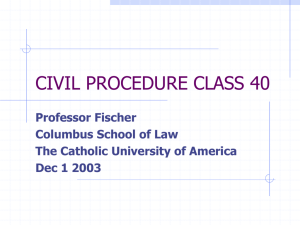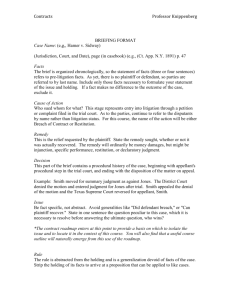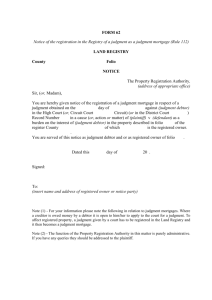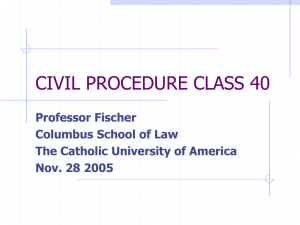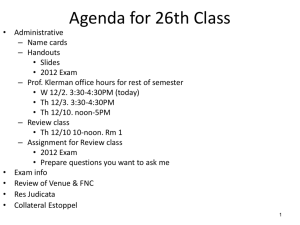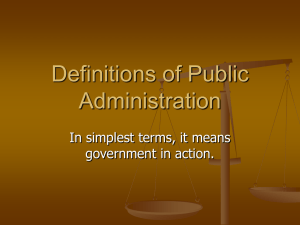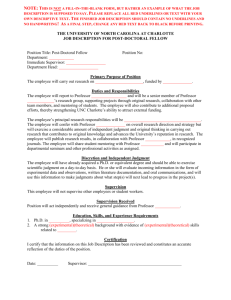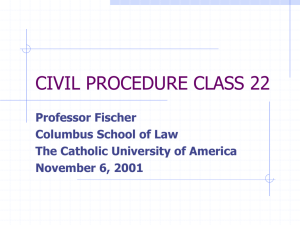Slides from Class 41 - Catholic University of America
advertisement
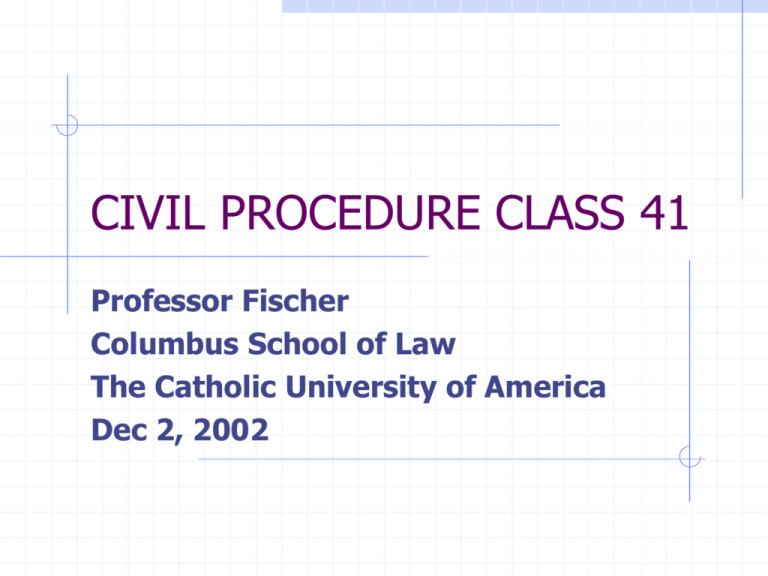
CIVIL PROCEDURE CLASS 41 Professor Fischer Columbus School of Law The Catholic University of America Dec 2, 2002 ANNOUNCEMENTS Exam review classes Exam is completely open book. EXAM TIPS Read questions carefully and remember to answer the question asked Use IRAC form for each issue in question Answer every question; manage your time carefully Get sufficient sleep the night before the exam. WRAP-UP OF LAST CLASS Claim preclusion Issue preclusion ELEMENTS OF ISSUE PRECLUSION Same issue Actually litigated thus an admission is not enough for issue preclusion to apply Actually decided by a valid and final judgment Determination is essential to judgment Some courts require mutuality, i.e. same parties NECESSARY TO THE JUDGMENT Davis sued Rios for negligence in an automobile collision. The jury found Rios negligent but also found Davis contributorily negligent. Judgment entered for Rios. Should the court in a subsquent claim by Rios for injuries suffered in the same collision hold that Rios was barred from relitigating on the basis that his contributory negligence determined in first proceeding? NECESSARY TO THE JUDGMENT The finding that Rios was negligent was not essential to the judgment and the judgment was not based thereon. Since the judgment was in favor of Rios he had not right to complain of or appeal from the finding that he was guilty of such negligence even if such finding had been without support in the evidence. Right of appeal is from a jdugment not a finding. NECESSARY TO THE JUDGMENT A useful test_ ask yourself if the issue had been decided the opposite way, would the same judgment have been entered? If so, the judgment did not depend on the way the issue was actually resolved. Applying this test to Rios, we find that once jury found Davis to be contributorily negligent, Rios had to win. JUDGMENT ON ALTERNATE GROUNDS What if judgment is explicitly based on alternate grounds? Strictly speaking, neither ground alone is necessary to judgment. Yet each supports the judgment and is made against the losing party, so all may be reviewed on appeal Old rule – each alternate ground entitled to preclusive effect JUDGMENT ON ALTERNATE GROUNDS Currently, there is a division of authority on this question. Restatement (Second) of Judgments states that “if a judgment of a court of first instance is based on determinations of two issues, either of which standing independently would be sufficient to support the restult, the judgment is not conclusive with respect to either issue standing alone.” HOULT CASE (3d Cir. 1998) What was Jennifer Hoult’s cause of action in the first action? What was the outcome of the first action? What is David Hoult’s cause of action in the second action? What is the procedural issue in the second action? How did the trial court rule? THE HOULT APPEAL Does the First Circuit affirm or dismiss Jennifer Hoult’s appeal? What is the First Circuit’s reasoning? MUTUALITY AND COLLATERAL ESTOPPEL Old rule: parties had to be the same New rule in federal court: Parklane Hosiery Co. v. Shore (1979) NOTE THAT PARKLANE applies only to federal courts. State courts are not obligated to follow Supreme Court. You will need to check the law carefully to see whether a jurisdiction has abandoned mutuality, and if so, to what extent. DEFENSIVE NON-MUTUAL COLLATERAL ESTOPPEL In Blonder-Tongue, the Supreme Court first endorses the use of nonmutual estoppel What are the key facts of Blonder-Tongue What is the policy justification for the Supreme Court’s reversal of its long-standing rule requiring mutuality? What is the difference between the use of collateral estoppel in Blonder-Tongue and in Parklane? DEFENSIVE NONMUTUAL ESTOPPEL Suit 1: P sues D1 (P loses on Issue A) Suit 1: P sues D2 (D2 pleads collateral estoppel to bar plaintiff from relitigating Issue A) PARKLANE HOSIERY V. SHORE Offensive nonmutual estoppel What are the key facts in Parklane? OFFENSIVE NONMUTUAL COLLATERAL ESTOPPEL Suit 1: P1 sues D (D loses on Issue A) Suit 2: P2 sues D (new plaintiff invokes collateral estoppel to establish Issue A in her suit against D) What are the risks posed by offensive use of estoppel? SUPREME COURT IN PARKLANE Does the Supreme Court categorically endorse or reject offensive nonmutual collateral estoppel? What factors must lower courts consider? 4 PARKLANE FACTORS 1. Could nonparty have joined prior litigation? 2. Was subsequent litigation foreseeable at time of first suit? 3. Is judgment being relied on consistent with prior judgments against this D? 4. Are there any procedural opportunities available to D in second action that did not exist in the first that would lead to a different result? FORUM SELECTION CLAUSES Parties may select a venue that is not a statutory venue by including a forum selection clause in a contract. In Bremen v. Zapata, 407 U.S. 1, 15 (1972), Supreme Court held that federal courts sitting in admiralty should enforce such clauses absent showing that doing so “would be unreasonable or unjust, or that the clause was invalid for such reasons as fraud or overreaching” Non-negotiable forum selection clauses have been enforced by the Supreme Court. PIPER AIRCRAFT CO. V. REYNO (1981) Landmark decision Who is the plaintiff? Who is plaintiff suing? What is the cause of action? Where does plaintiff bring the action? Why does plaintiff choose that forum?
